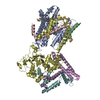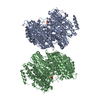+ データを開く
データを開く
- 基本情報
基本情報
| 登録情報 | データベース: PDB / ID: 7kam | |||||||||||||||||||||||||||||||||||||||||||||||||||||||||||||||||||||||||||||||||||||||||||||
|---|---|---|---|---|---|---|---|---|---|---|---|---|---|---|---|---|---|---|---|---|---|---|---|---|---|---|---|---|---|---|---|---|---|---|---|---|---|---|---|---|---|---|---|---|---|---|---|---|---|---|---|---|---|---|---|---|---|---|---|---|---|---|---|---|---|---|---|---|---|---|---|---|---|---|---|---|---|---|---|---|---|---|---|---|---|---|---|---|---|---|---|---|---|---|
| タイトル | Cryo-EM structure of the Sec complex from T. lanuginosus, wild-type, class with Sec62, plug-closed conformation | |||||||||||||||||||||||||||||||||||||||||||||||||||||||||||||||||||||||||||||||||||||||||||||
 要素 要素 |
| |||||||||||||||||||||||||||||||||||||||||||||||||||||||||||||||||||||||||||||||||||||||||||||
 キーワード キーワード | PROTEIN TRANSPORT / Sec61 / translocon / endoplasmic reticulum / protein translocation / Sec62 / Sec63 / channel | |||||||||||||||||||||||||||||||||||||||||||||||||||||||||||||||||||||||||||||||||||||||||||||
| 機能・相同性 | Tetratricopeptide repeat domain / Serine Threonine Protein Phosphatase 5, Tetratricopeptide repeat / Alpha Horseshoe / Mainly Alpha 機能・相同性情報 機能・相同性情報 | |||||||||||||||||||||||||||||||||||||||||||||||||||||||||||||||||||||||||||||||||||||||||||||
| 生物種 |   Thermomyces lanuginosus (菌類) Thermomyces lanuginosus (菌類) | |||||||||||||||||||||||||||||||||||||||||||||||||||||||||||||||||||||||||||||||||||||||||||||
| 手法 | 電子顕微鏡法 / 単粒子再構成法 / クライオ電子顕微鏡法 / 解像度: 3.8 Å | |||||||||||||||||||||||||||||||||||||||||||||||||||||||||||||||||||||||||||||||||||||||||||||
 データ登録者 データ登録者 | Itskanov, S. / Park, E. | |||||||||||||||||||||||||||||||||||||||||||||||||||||||||||||||||||||||||||||||||||||||||||||
| 資金援助 |  米国, 1件 米国, 1件
| |||||||||||||||||||||||||||||||||||||||||||||||||||||||||||||||||||||||||||||||||||||||||||||
 引用 引用 |  ジャーナル: Nat Struct Mol Biol / 年: 2021 ジャーナル: Nat Struct Mol Biol / 年: 2021タイトル: Stepwise gating of the Sec61 protein-conducting channel by Sec63 and Sec62. 著者: Samuel Itskanov / Katie M Kuo / James C Gumbart / Eunyong Park /  要旨: Many proteins are transported into the endoplasmic reticulum by the universally conserved Sec61 channel. Post-translational transport requires two additional proteins, Sec62 and Sec63, but their ...Many proteins are transported into the endoplasmic reticulum by the universally conserved Sec61 channel. Post-translational transport requires two additional proteins, Sec62 and Sec63, but their functions are poorly defined. In the present study, we determined cryo-electron microscopy (cryo-EM) structures of several variants of Sec61-Sec62-Sec63 complexes from Saccharomyces cerevisiae and Thermomyces lanuginosus and show that Sec62 and Sec63 induce opening of the Sec61 channel. Without Sec62, the translocation pore of Sec61 remains closed by the plug domain, rendering the channel inactive. We further show that the lateral gate of Sec61 must first be partially opened by interactions between Sec61 and Sec63 in cytosolic and luminal domains, a simultaneous disruption of which completely closes the channel. The structures and molecular dynamics simulations suggest that Sec62 may also prevent lipids from invading the channel through the open lateral gate. Our study shows how Sec63 and Sec62 work together in a hierarchical manner to activate Sec61 for post-translational protein translocation. | |||||||||||||||||||||||||||||||||||||||||||||||||||||||||||||||||||||||||||||||||||||||||||||
| 履歴 |
|
- 構造の表示
構造の表示
| ムービー |
 ムービービューア ムービービューア |
|---|---|
| 構造ビューア | 分子:  Molmil Molmil Jmol/JSmol Jmol/JSmol |
- ダウンロードとリンク
ダウンロードとリンク
- ダウンロード
ダウンロード
| PDBx/mmCIF形式 |  7kam.cif.gz 7kam.cif.gz | 269.8 KB | 表示 |  PDBx/mmCIF形式 PDBx/mmCIF形式 |
|---|---|---|---|---|
| PDB形式 |  pdb7kam.ent.gz pdb7kam.ent.gz | 203.8 KB | 表示 |  PDB形式 PDB形式 |
| PDBx/mmJSON形式 |  7kam.json.gz 7kam.json.gz | ツリー表示 |  PDBx/mmJSON形式 PDBx/mmJSON形式 | |
| その他 |  その他のダウンロード その他のダウンロード |
-検証レポート
| 文書・要旨 |  7kam_validation.pdf.gz 7kam_validation.pdf.gz | 1.4 MB | 表示 |  wwPDB検証レポート wwPDB検証レポート |
|---|---|---|---|---|
| 文書・詳細版 |  7kam_full_validation.pdf.gz 7kam_full_validation.pdf.gz | 1.4 MB | 表示 | |
| XML形式データ |  7kam_validation.xml.gz 7kam_validation.xml.gz | 50.8 KB | 表示 | |
| CIF形式データ |  7kam_validation.cif.gz 7kam_validation.cif.gz | 76.5 KB | 表示 | |
| アーカイブディレクトリ |  https://data.pdbj.org/pub/pdb/validation_reports/ka/7kam https://data.pdbj.org/pub/pdb/validation_reports/ka/7kam ftp://data.pdbj.org/pub/pdb/validation_reports/ka/7kam ftp://data.pdbj.org/pub/pdb/validation_reports/ka/7kam | HTTPS FTP |
-関連構造データ
| 関連構造データ |  22775MC  7kahC  7kaiC  7kajC  7kakC  7kalC  7kanC  7kaoC  7kapC  7kaqC  7karC  7kasC  7katC  7kauC  7kb5C M: このデータのモデリングに利用したマップデータ C: 同じ文献を引用 ( |
|---|---|
| 類似構造データ |
- リンク
リンク
- 集合体
集合体
| 登録構造単位 | 
|
|---|---|
| 1 |
|
- 要素
要素
-Protein transport channel Sec61 complex, ... , 3種, 3分子 ACB
| #1: タンパク質 | 分子量: 52427.430 Da / 分子数: 1 / 由来タイプ: 組換発現 / 由来: (組換発現)   Thermomyces lanuginosus (菌類) Thermomyces lanuginosus (菌類)発現宿主:  株 (発現宿主): ATCC 204508 / S288c |
|---|---|
| #2: タンパク質 | 分子量: 7852.352 Da / 分子数: 1 / 由来タイプ: 組換発現 / 由来: (組換発現)   Thermomyces lanuginosus (菌類) Thermomyces lanuginosus (菌類)発現宿主:  株 (発現宿主): ATCC 204508 / S288c |
| #3: タンパク質 | 分子量: 12491.097 Da / 分子数: 1 / 由来タイプ: 組換発現 / 由来: (組換発現)   Thermomyces lanuginosus (菌類) Thermomyces lanuginosus (菌類)発現宿主:  株 (発現宿主): ATCC 204508 / S288c |
-Protein transport protein ... , 4種, 4分子 DEFG
| #4: タンパク質 | 分子量: 79976.703 Da / 分子数: 1 / 由来タイプ: 組換発現 / 由来: (組換発現)   Thermomyces lanuginosus (菌類) Thermomyces lanuginosus (菌類)発現宿主:  株 (発現宿主): ATCC 204508 / S288c |
|---|---|
| #5: タンパク質 | 分子量: 27555.285 Da / 分子数: 1 / 由来タイプ: 組換発現 / 由来: (組換発現)   Thermomyces lanuginosus (菌類) Thermomyces lanuginosus (菌類)発現宿主:  株 (発現宿主): ATCC 204508 / S288c |
| #6: タンパク質 | 分子量: 23382.234 Da / 分子数: 1 / 由来タイプ: 組換発現 / 由来: (組換発現)   Thermomyces lanuginosus (菌類) Thermomyces lanuginosus (菌類)発現宿主:  株 (発現宿主): ATCC 204508 / S288c |
| #7: タンパク質 | 分子量: 44460.074 Da / 分子数: 1 / 由来タイプ: 組換発現 / 由来: (組換発現)   Thermomyces lanuginosus (菌類) Thermomyces lanuginosus (菌類)発現宿主:  株 (発現宿主): ATCC 204508 / S288c |
-詳細
| Has protein modification | N |
|---|
-実験情報
-実験
| 実験 | 手法: 電子顕微鏡法 |
|---|---|
| EM実験 | 試料の集合状態: PARTICLE / 3次元再構成法: 単粒子再構成法 |
- 試料調製
試料調製
| 構成要素 | 名称: Endoplasmic reticulum protein-transport machinery Sec complex from T. lanuginosus タイプ: COMPLEX / Entity ID: all / 由来: RECOMBINANT |
|---|---|
| 分子量 | 実験値: NO |
| 由来(天然) | 生物種:   Thermomyces lanuginosus (菌類) Thermomyces lanuginosus (菌類) |
| 由来(組換発現) | 生物種:  |
| 緩衝液 | pH: 7.5 |
| 試料 | 濃度: 5 mg/ml / 包埋: NO / シャドウイング: NO / 染色: NO / 凍結: YES |
| 試料支持 | グリッドの材料: GOLD / グリッドのサイズ: 400 divisions/in. / グリッドのタイプ: Quantifoil R1.2/1.3 |
| 急速凍結 | 装置: FEI VITROBOT MARK IV / 凍結剤: ETHANE / 湿度: 100 % / 凍結前の試料温度: 277 K |
- 電子顕微鏡撮影
電子顕微鏡撮影
| 実験機器 |  モデル: Talos Arctica / 画像提供: FEI Company |
|---|---|
| 顕微鏡 | モデル: FEI TALOS ARCTICA |
| 電子銃 | 電子線源:  FIELD EMISSION GUN / 加速電圧: 200 kV / 照射モード: FLOOD BEAM FIELD EMISSION GUN / 加速電圧: 200 kV / 照射モード: FLOOD BEAM |
| 電子レンズ | モード: BRIGHT FIELD / 倍率(補正後): 43860 X / アライメント法: COMA FREE |
| 試料ホルダ | 凍結剤: NITROGEN 試料ホルダーモデル: FEI TITAN KRIOS AUTOGRID HOLDER |
| 撮影 | 電子線照射量: 50 e/Å2 / フィルム・検出器のモデル: GATAN K3 (6k x 4k) |
- 解析
解析
| ソフトウェア | 名称: PHENIX / バージョン: 1.17.1_3660: / 分類: 精密化 | ||||||||||||||||||||||||||||||||||||
|---|---|---|---|---|---|---|---|---|---|---|---|---|---|---|---|---|---|---|---|---|---|---|---|---|---|---|---|---|---|---|---|---|---|---|---|---|---|
| EMソフトウェア |
| ||||||||||||||||||||||||||||||||||||
| CTF補正 | タイプ: PHASE FLIPPING AND AMPLITUDE CORRECTION | ||||||||||||||||||||||||||||||||||||
| 粒子像の選択 | 選択した粒子像数: 1632659 / 詳細: autopicked particles | ||||||||||||||||||||||||||||||||||||
| 対称性 | 点対称性: C1 (非対称) | ||||||||||||||||||||||||||||||||||||
| 3次元再構成 | 解像度: 3.8 Å / 解像度の算出法: FSC 0.143 CUT-OFF / 粒子像の数: 143227 / アルゴリズム: FOURIER SPACE / 対称性のタイプ: POINT | ||||||||||||||||||||||||||||||||||||
| 拘束条件 |
|
 ムービー
ムービー コントローラー
コントローラー





























 PDBj
PDBj